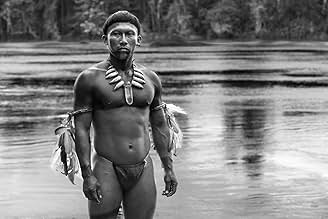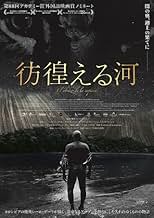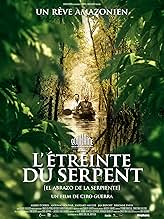CALIFICACIÓN DE IMDb
7.8/10
25 k
TU CALIFICACIÓN
La historia de la relación entre Karamakate, un chamán amazónico y último sobreviviente de su pueblo, y dos científicos que trabajan juntos durante cuarenta años para buscar en el Amazonas u... Leer todoLa historia de la relación entre Karamakate, un chamán amazónico y último sobreviviente de su pueblo, y dos científicos que trabajan juntos durante cuarenta años para buscar en el Amazonas una planta curativa sagrada.La historia de la relación entre Karamakate, un chamán amazónico y último sobreviviente de su pueblo, y dos científicos que trabajan juntos durante cuarenta años para buscar en el Amazonas una planta curativa sagrada.
- Dirección
- Guionistas
- Elenco
- Nominado a 1 premio Óscar
- 46 premios ganados y 32 nominaciones en total
Antonio Bolívar
- Old Karamakate
- (as Tafillama-Antonio Bolívar Salvador)
Miguel Dionisio Ramos
- Manduca
- (as Yauenkü Miguee)
Jesús Rodríguez
- Borracho Cohiuano
- (as Jesús Rodríguez)
Opiniones destacadas
For 350 years, Spain built a vast empire in South America based on the labor and exploitation of the Indian population, forcing them to accept Christianity while decimating their culture, religion, and even their language. In the late 19th and early 20th Centuries, "rubber barons" rounded up all the Indians and forced them to tap rubber out of the trees in rainforest zones leading to slavery and human rights abuses. Winner of the top Director's Fortnight Award at Cannes and Colombia's submission to the Oscars in the Best Foreign Film category, Ciro Guerra's ("The Wind Journeys") Embrace of the Serpent (El abrazo de la serpiente) provides a powerful insight into the effects of colonialism on an indigenous population.
The film, in which nine different languages are spoken, follows two interconnected stories based on the travel journals of two Amazonian explorers thirty years apart, German scientist Theodor Koch-Grunberg (Jan Bijvoet, "Borgman") and American plant enthusiast Richard Evans Schultes (Brionne Davis, "Avenged"). Both men are seeking the Yakruna plant to discover its powerful ability to heal. The two explorers are accompanied by the Amazonian shaman Karamakate (Niblio Torres as a young man and Antonio Bolivar as the elder) not only to find the sacred plant for research purposes but to learn deeper truths about themselves and the nature of reality. Karamakate, the last surviving member of his tribe, guards the secrets of Yakruna, a last symbol of independence for his people.
Filmed in black and white by cinematographer David Gallego ("Cecilia"), it is the first film to be shot on location in the Amazon in thirty years and its gorgeous kaleidoscope of rivers and forests, and the blending of time creates a surreal, dreamlike atmosphere, fortified by native songs and chants. As the film begins, a young Karamakate, armed with a spear and dressed in native attire, stands menacingly as a boat approaches the shore containing the German scientist and his companion Manduca (Yauenku Migue), a native dressed in white man's clothing.
Manduca asks the shaman to cure the explorer who is very sick, but Karamakate, who is familiar with the destructive nature of the white man, refuses. When Theo tells him, however, that he has seen survivors of his people and will take him to them, the young shaman agrees as long as the white man follows his "prohibitions" about disturbing the natural flow of the jungle. The two scientists, Theo in 1909 and Evan in 1940, follow the same path and explore the same places drastically changed over the years. Karamakate, as he did with Theo, acts as Evan's guide and considers himself as a "chullachaqui," an empty shell of a human being, and must become a man once more in tune with nature.
Two scenes stand out. After a night of singing and dancing with a native group and demonstrating Western technology, Theodor becomes angry when a member of the group wants to keep his compass in exchange for goods. To rationalize his anger, he tells Karamakate that owning a compass would disturb their traditions of finding locations through the sun and stars, but the shaman tells him "You cannot forbid them to learn. Knowledge belongs to all men." The other scene is one of pure horror when a priest (Luigi Sciamanna, "Secreto de Confesion") at a Spanish mission is found brutally whipping his young students until Theodor intervenes.
Despite an element of religious madness that feels out of sync with the tone of the film, Embrace of the Serpent soars when its focus is on spiritual awareness. The shaman tells both scientists the need to unburden themselves of their material possessions and explore the mystery of consciousness alone without their physical and psychological baggage. They cannot be cured of their illness, he tells them, because they have forgotten how to dream. After Evan ingests a native plant following a heated exchange with Karamakate, a montage of brilliant, swirling colors pushes the boundary of what we think is real and allows us to remember how to dream.
The film, in which nine different languages are spoken, follows two interconnected stories based on the travel journals of two Amazonian explorers thirty years apart, German scientist Theodor Koch-Grunberg (Jan Bijvoet, "Borgman") and American plant enthusiast Richard Evans Schultes (Brionne Davis, "Avenged"). Both men are seeking the Yakruna plant to discover its powerful ability to heal. The two explorers are accompanied by the Amazonian shaman Karamakate (Niblio Torres as a young man and Antonio Bolivar as the elder) not only to find the sacred plant for research purposes but to learn deeper truths about themselves and the nature of reality. Karamakate, the last surviving member of his tribe, guards the secrets of Yakruna, a last symbol of independence for his people.
Filmed in black and white by cinematographer David Gallego ("Cecilia"), it is the first film to be shot on location in the Amazon in thirty years and its gorgeous kaleidoscope of rivers and forests, and the blending of time creates a surreal, dreamlike atmosphere, fortified by native songs and chants. As the film begins, a young Karamakate, armed with a spear and dressed in native attire, stands menacingly as a boat approaches the shore containing the German scientist and his companion Manduca (Yauenku Migue), a native dressed in white man's clothing.
Manduca asks the shaman to cure the explorer who is very sick, but Karamakate, who is familiar with the destructive nature of the white man, refuses. When Theo tells him, however, that he has seen survivors of his people and will take him to them, the young shaman agrees as long as the white man follows his "prohibitions" about disturbing the natural flow of the jungle. The two scientists, Theo in 1909 and Evan in 1940, follow the same path and explore the same places drastically changed over the years. Karamakate, as he did with Theo, acts as Evan's guide and considers himself as a "chullachaqui," an empty shell of a human being, and must become a man once more in tune with nature.
Two scenes stand out. After a night of singing and dancing with a native group and demonstrating Western technology, Theodor becomes angry when a member of the group wants to keep his compass in exchange for goods. To rationalize his anger, he tells Karamakate that owning a compass would disturb their traditions of finding locations through the sun and stars, but the shaman tells him "You cannot forbid them to learn. Knowledge belongs to all men." The other scene is one of pure horror when a priest (Luigi Sciamanna, "Secreto de Confesion") at a Spanish mission is found brutally whipping his young students until Theodor intervenes.
Despite an element of religious madness that feels out of sync with the tone of the film, Embrace of the Serpent soars when its focus is on spiritual awareness. The shaman tells both scientists the need to unburden themselves of their material possessions and explore the mystery of consciousness alone without their physical and psychological baggage. They cannot be cured of their illness, he tells them, because they have forgotten how to dream. After Evan ingests a native plant following a heated exchange with Karamakate, a montage of brilliant, swirling colors pushes the boundary of what we think is real and allows us to remember how to dream.
I love how this movie is put together. By combining the accounts of two explorers - over 30 years apart - it manages to tell a story of a world changing. You can see how actions made by the first explorer directly changes the world of the people they meet. Mostly in a bad way. The movie conveys, with a sadness, how much the people of these tribes lost because of the way they were handled by "white people". But this is not the time tested "gone with the wolves"-story. It's an artistic and stylistic, yet believable, account of the old meeting the new.
One thought though: While it is an interesting discussion why it's in black and white, I think the movie would have been better off in color. At least partly. Black and white is nice, but the jungle scenery in this movie could have been breathtaking in color - but the again, maybe that's the point.
One thought though: While it is an interesting discussion why it's in black and white, I think the movie would have been better off in color. At least partly. Black and white is nice, but the jungle scenery in this movie could have been breathtaking in color - but the again, maybe that's the point.
Honestly, how this didn't get one iota of the hype that Son of Saul got is beyond me. As far as I'm concerned, the real winner of that Oscar for foreign-language film. It's so incredibly fixating and transportive in the world it creates. The cinematography is exquisite, the sound design impressive, and the directorial achievement here is just incredible. I never entirely understood everything that was going on, but it didn't stop the film from fully capturing me. The acting is also uniformly strong, and the film could have been even more confusing had it not been to the spectacular editing, which did a great job going from one storyline to the next, and one timeline to the other. I just think this is a really magical, really special film. It deserves to be seen by many more people than it has.
Another Ciro Guerra's masterpiece. Fascinating movie. After "The wind Journeys" Guerra shows again his talent with an incredible history about the Amazonas jungle back in the early 1900s. The beauty and uniqueness of the scenes is mind blowing. The sound takes you deep inside the jungle. The story is a thriller that makes you live the most strange adventures that you could ever imagine in the jungle. It is based on two diaries written by a German and American travelers. All actors have an incredible command of the indigenous dialect. Additionally, the native indigenous actors seem to be truly professionals. Enjoyed every single minute. A must see.
"Embrace of the Serpent" (2015 release from Colombia; 125 min.) brings the story of two explorers who, 3 decades apart (1909 and 1940, respectively) explore the Amazon region, albeit with very different motives. They both end up enlisting the help of the same man, Karmakate, one of the few remaining shamans.
Couple of comments: first, it takes a while to fully understand and grasp what is really happening, and that the local is the same man, simply 30 years older than before. It eventually also becomes clear that this film calls out "the white man" for what he has done to the jungle and the indigenous peoples. At some point Theo (the first explorer) and his two travel mates come to a Mission, where a priest runs things. Later on, the effects of the 'rubber wars' become all too clear. Second, the movie is shot in gorgeous black and white. This is the second film in a row that I've seen in theaters that is in B&W, what are the chances? (the other film was "Creative Control"). Third, Belgian actor Jan Bijvoet gives a truly stunning performance as Theo. You will be blown away. "Embrace of the Serpent was nominated for the Best Foreign Language Film Oscar this year. While it didn't win ("Son of Saul" did), it doesn't diminish anything of the intrinsic quality of this film. With that, I've now finally seen all 5 nominees in the Best Foreign Language Movie Oscar category, and I am amazed at the collective talent in those 5 movies.
"Embrace of the Serpent" opened last weekend at my local art-house theater here in Cincinnati. The Sunday early evening screening was attend quite nicely, much better than I had expected. It confirms that there is a market for this type of top-notch quality foreign movie. Truly world cinema at its best. If you get a chance to check it out, be it in the theater, on VOD or eventually on DVD/Blu-ray, do not miss it! "Embrace of the Serpent" is HIGHLY RECOMMENDED!
Couple of comments: first, it takes a while to fully understand and grasp what is really happening, and that the local is the same man, simply 30 years older than before. It eventually also becomes clear that this film calls out "the white man" for what he has done to the jungle and the indigenous peoples. At some point Theo (the first explorer) and his two travel mates come to a Mission, where a priest runs things. Later on, the effects of the 'rubber wars' become all too clear. Second, the movie is shot in gorgeous black and white. This is the second film in a row that I've seen in theaters that is in B&W, what are the chances? (the other film was "Creative Control"). Third, Belgian actor Jan Bijvoet gives a truly stunning performance as Theo. You will be blown away. "Embrace of the Serpent was nominated for the Best Foreign Language Film Oscar this year. While it didn't win ("Son of Saul" did), it doesn't diminish anything of the intrinsic quality of this film. With that, I've now finally seen all 5 nominees in the Best Foreign Language Movie Oscar category, and I am amazed at the collective talent in those 5 movies.
"Embrace of the Serpent" opened last weekend at my local art-house theater here in Cincinnati. The Sunday early evening screening was attend quite nicely, much better than I had expected. It confirms that there is a market for this type of top-notch quality foreign movie. Truly world cinema at its best. If you get a chance to check it out, be it in the theater, on VOD or eventually on DVD/Blu-ray, do not miss it! "Embrace of the Serpent" is HIGHLY RECOMMENDED!
¿Sabías que…?
- TriviaThe scene where a man is praised to be the Messiah is based on an actual event.
- Citas
Young Karamakate: Knowledge belongs to all. You do not understand that. You are just a white man.
- ConexionesFeatured in Starfilm (2017)
- Bandas sonorasEmbrace Of The Serpent
(Theme from Original Motion Picture Soundtrack)
by Nascuy Linares
© 2016 Plaza Mayor Company, Ltd.
Selecciones populares
Inicia sesión para calificar y agrega a la lista de videos para obtener recomendaciones personalizadas
- How long is Embrace of the Serpent?Con tecnología de Alexa
Detalles
- Fecha de lanzamiento
- Países de origen
- Sitios oficiales
- Idiomas
- También se conoce como
- Embrace of the Serpent
- Locaciones de filmación
- Productoras
- Ver más créditos de la compañía en IMDbPro
Taquilla
- Presupuesto
- USD 1,400,000 (estimado)
- Total en EE. UU. y Canadá
- USD 1,329,249
- Fin de semana de estreno en EE. UU. y Canadá
- USD 50,955
- 21 feb 2016
- Total a nivel mundial
- USD 3,217,212
- Tiempo de ejecución2 horas 5 minutos
- Color
- Mezcla de sonido
- Relación de aspecto
- 2.35 : 1
Contribuir a esta página
Sugiere una edición o agrega el contenido que falta

Principales brechas de datos
By what name was El abrazo de la serpiente (2015) officially released in India in English?
Responda























